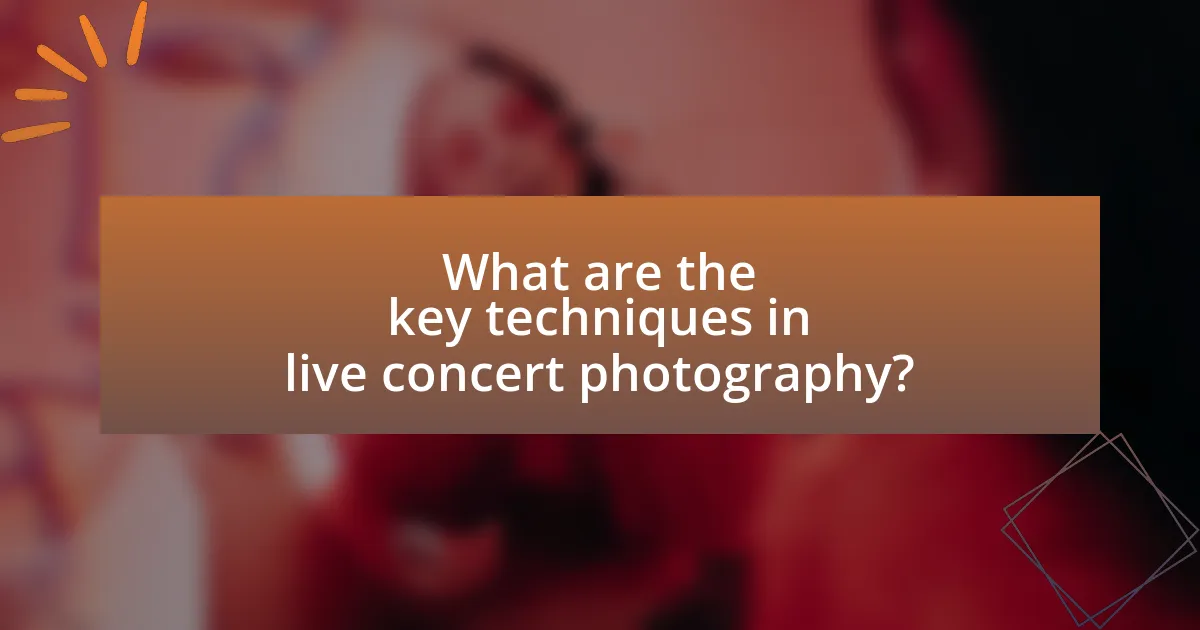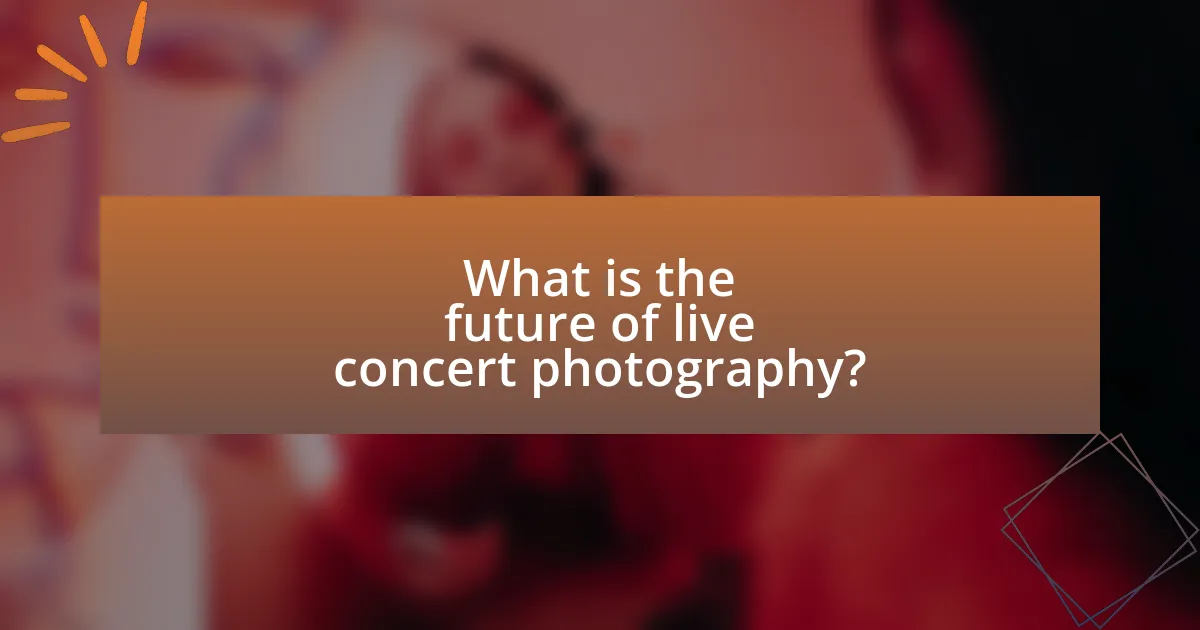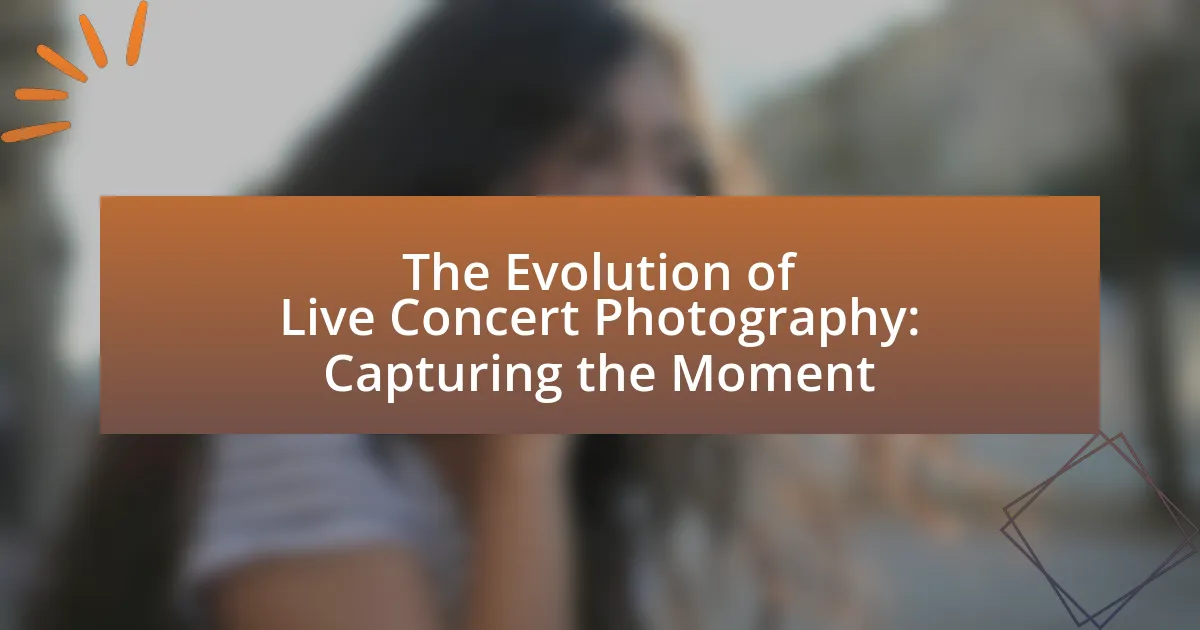The article examines the evolution of live concert photography, highlighting its transformation from early static images to dynamic visuals that capture the energy of performances. It discusses the impact of technological advancements, such as the shift from film to digital cameras and the rise of social media, which have enhanced the quality and accessibility of concert photography. Key techniques, challenges, and the importance of concert photography in artist promotion and audience engagement are also explored. Additionally, the article addresses future trends, including the influence of virtual and augmented reality on the field.

What is the Evolution of Live Concert Photography?
The evolution of live concert photography has transitioned from early static images to dynamic, immersive visuals that capture the energy of performances. Initially, in the 1950s and 1960s, concert photography was limited by technology, with photographers using film cameras that required long exposure times, resulting in blurry images. As technology advanced, the introduction of faster film and later digital cameras in the 2000s allowed for higher-quality images and the ability to shoot in low light conditions, enhancing the clarity and vibrancy of concert photos.
Moreover, the rise of social media platforms in the 2010s transformed live concert photography by enabling instant sharing and interaction, leading to a new era where photographers could reach wider audiences and engage with fans in real-time. This evolution reflects broader changes in music culture and technology, illustrating how advancements in equipment and digital platforms have shaped the way live performances are documented and experienced.
How has live concert photography changed over the decades?
Live concert photography has evolved significantly over the decades, transitioning from film to digital formats and incorporating advanced technology. In the 1970s and 1980s, photographers primarily used film cameras, which limited the number of shots and required careful planning due to the cost of film and development. The introduction of digital cameras in the late 1990s revolutionized the field, allowing for immediate feedback and the ability to take numerous shots without the constraints of film.
Additionally, the rise of social media platforms in the 2000s transformed how concert photography is shared and consumed, enabling photographers to reach wider audiences instantly. The use of smartphones has also democratized concert photography, allowing fans to capture and share their experiences in real-time. Furthermore, advancements in camera technology, such as improved low-light performance and autofocus systems, have enhanced the quality of concert images, making it easier to capture dynamic performances. Overall, these changes reflect a shift towards greater accessibility, immediacy, and quality in live concert photography.
What technological advancements have influenced live concert photography?
Technological advancements such as digital cameras, high ISO capabilities, and smartphone technology have significantly influenced live concert photography. Digital cameras have replaced film cameras, allowing for immediate image review and editing, which enhances the photographer’s ability to capture fleeting moments. High ISO capabilities enable photographers to shoot in low-light conditions typical of concerts without sacrificing image quality, resulting in clearer and more vibrant photos. Additionally, the rise of smartphones equipped with advanced camera features has democratized concert photography, allowing more fans to capture and share their experiences instantly. These advancements collectively improve the quality and accessibility of live concert photography.
How have cultural shifts impacted the style of concert photography?
Cultural shifts have significantly impacted the style of concert photography by influencing the aesthetics, techniques, and accessibility of images captured during live performances. For instance, the rise of social media platforms has led to a demand for more candid and spontaneous shots, moving away from traditional posed images. This shift is evident in the prevalence of smartphone photography at concerts, which allows fans to share real-time experiences, thus democratizing the art form. Additionally, the increasing emphasis on diversity and representation in music has prompted photographers to focus on a wider range of artists and genres, reflecting broader societal changes. The evolution of concert photography is also marked by the integration of multimedia elements, such as video and interactive content, driven by cultural trends towards immersive experiences.
Why is live concert photography important in the music industry?
Live concert photography is important in the music industry because it visually documents performances, creating a lasting record of artists’ work and audience engagement. This form of photography captures the energy and emotion of live events, which can be used for promotional materials, social media, and album artwork, enhancing an artist’s brand and reach. Furthermore, studies show that visual content significantly increases audience engagement; for instance, posts with images receive 94% more views than those without. This underscores the role of live concert photography in not only preserving moments but also in driving the commercial success of artists and their music.
What role does concert photography play in artist promotion?
Concert photography plays a crucial role in artist promotion by visually capturing live performances, which enhances an artist’s public image and marketability. High-quality concert images serve as powerful marketing tools, allowing artists to showcase their energy, stage presence, and connection with fans. These images are often shared across social media platforms, increasing visibility and engagement, which can lead to higher ticket sales and streaming numbers. Additionally, concert photography can be featured in promotional materials, press releases, and music videos, further solidifying an artist’s brand identity and appeal.
How does concert photography contribute to audience engagement?
Concert photography enhances audience engagement by visually capturing the energy and emotion of live performances, which fosters a deeper connection between the artists and their fans. High-quality images from concerts can evoke feelings of nostalgia and excitement, encouraging fans to share their experiences on social media platforms. According to a study by the Pew Research Center, 72% of adults use social media to share experiences, indicating that concert photography plays a significant role in amplifying audience interaction and community building around music events. This visual storytelling not only promotes the artists but also creates a shared experience among fans, further solidifying their engagement with the music and the live event.

What are the key techniques in live concert photography?
The key techniques in live concert photography include using fast shutter speeds, understanding lighting conditions, and composing dynamic shots. Fast shutter speeds, typically 1/250s or faster, freeze motion and capture sharp images of performers. Understanding lighting conditions is crucial, as concerts often feature low light and colored lights, requiring photographers to adjust ISO settings and aperture to achieve the best exposure. Composing dynamic shots involves framing the subject effectively, utilizing angles, and capturing candid moments that convey the energy of the performance. These techniques are essential for creating impactful and memorable concert images.
How do photographers capture the essence of a live performance?
Photographers capture the essence of a live performance by utilizing techniques such as timing, composition, and emotional engagement. They focus on key moments, like a musician’s expression or audience reactions, to convey the atmosphere and energy of the event. For instance, capturing a guitarist mid-solo can highlight the intensity of the performance, while images of the crowd can reflect the overall vibe. Additionally, photographers often use fast shutter speeds to freeze action and low light settings to enhance mood, which are essential in live environments where lighting can be unpredictable. This approach allows them to create images that resonate with viewers, effectively translating the live experience into a visual narrative.
What camera settings are essential for concert photography?
Essential camera settings for concert photography include a wide aperture (f/1.8 to f/2.8) to allow maximum light, a fast shutter speed (1/200s or faster) to freeze motion, and a high ISO (800 to 6400) to capture details in low light. These settings are crucial because concerts often occur in dimly lit environments, and using a wide aperture helps achieve a shallow depth of field, isolating the subject. A fast shutter speed prevents motion blur from performers’ movements, while a higher ISO compensates for low light, ensuring the images are well-exposed.
How do lighting conditions affect concert photography techniques?
Lighting conditions significantly influence concert photography techniques by dictating camera settings, composition, and post-processing methods. In low-light environments, photographers often increase ISO settings to capture more light, which can introduce noise, necessitating the use of noise reduction techniques in post-processing. Additionally, the dynamic range of lighting at concerts, with bright stage lights contrasting against darker backgrounds, requires careful exposure adjustments to avoid blown highlights or underexposed shadows. For instance, using faster shutter speeds can freeze motion but may require wider apertures to maintain adequate exposure. These adjustments are essential for achieving sharp, well-exposed images that accurately represent the concert atmosphere.
What challenges do photographers face during live events?
Photographers face several challenges during live events, including lighting conditions, crowd movement, and access restrictions. Lighting conditions can vary significantly, making it difficult to capture clear images without the right equipment; for instance, low light can lead to blurry photos if the shutter speed is too slow. Crowd movement poses another challenge, as photographers must navigate through audiences while trying to maintain focus on the subject, often resulting in obstructed views. Access restrictions, such as barriers or designated photo pits, limit the angles and proximity to the performers, which can hinder the ability to capture dynamic shots. These challenges require photographers to be adaptable and skilled in managing their equipment and surroundings to achieve the desired results.
How can photographers overcome obstacles like low light and movement?
Photographers can overcome obstacles like low light and movement by utilizing faster lenses, increasing ISO settings, and employing stabilization techniques. Fast lenses with wide apertures allow more light to enter the camera, which is crucial in low-light environments typical of concerts. Increasing the ISO setting enhances the camera’s sensitivity to light, enabling clearer images in dim conditions, although it may introduce noise. Additionally, using image stabilization features or techniques such as panning can help mitigate the effects of movement, resulting in sharper images. These methods are supported by the fact that professional concert photographers often rely on these strategies to achieve high-quality results in challenging lighting and dynamic environments.
What strategies can be employed to get the best shots in crowded venues?
To get the best shots in crowded venues, photographers should utilize strategic positioning, quick reflexes, and effective communication. Positioning oneself near the stage or at elevated points can provide better angles and visibility, while quick reflexes allow for capturing spontaneous moments amidst the crowd. Effective communication with venue staff and security can facilitate access to prime shooting locations and ensure safety. These strategies are supported by the fact that many professional concert photographers emphasize the importance of being proactive in securing advantageous spots and adapting to the dynamic environment of live events.

What is the future of live concert photography?
The future of live concert photography is increasingly intertwined with advancements in technology, particularly in the realms of digital imaging and social media. As artists and venues prioritize visual content for marketing and engagement, photographers will likely adopt more sophisticated equipment, such as high-resolution cameras and drones, to capture dynamic perspectives. Additionally, the rise of live streaming and virtual concerts necessitates photographers to adapt their skills to create compelling visuals that resonate in both physical and digital spaces. This evolution is supported by the growing demand for instant content sharing, as evidenced by platforms like Instagram, where concert imagery plays a crucial role in audience interaction and artist promotion.
How is technology shaping the future of concert photography?
Technology is significantly shaping the future of concert photography by enhancing image quality, streamlining workflows, and enabling innovative storytelling techniques. Advanced camera systems, such as mirrorless cameras with high ISO capabilities, allow photographers to capture stunning images in low-light environments typical of concerts. Additionally, software advancements in editing tools, like Adobe Lightroom and Photoshop, facilitate faster post-processing, enabling photographers to deliver high-quality images more efficiently. Furthermore, the integration of drones and 360-degree cameras is revolutionizing perspectives in concert photography, allowing for immersive experiences that engage audiences in new ways. These technological advancements collectively enhance the ability to capture and share the dynamic atmosphere of live performances, making concert photography more accessible and impactful.
What role will social media play in the evolution of concert photography?
Social media will significantly enhance the evolution of concert photography by providing a platform for instant sharing and audience engagement. This immediacy allows photographers to showcase their work in real-time, reaching wider audiences and gaining immediate feedback. For instance, platforms like Instagram and Twitter enable photographers to post images directly from concerts, creating a dynamic interaction between artists, fans, and photographers. Additionally, the use of hashtags and geotags increases visibility, allowing concert photography to be discovered by users interested in specific events or artists. This shift not only democratizes the field, allowing emerging photographers to gain recognition but also influences the style and content of concert photography, as photographers adapt to the preferences and trends observed on social media.
How might virtual reality and augmented reality impact concert photography?
Virtual reality (VR) and augmented reality (AR) will significantly transform concert photography by enhancing audience engagement and providing immersive experiences. VR can create fully immersive environments where users can experience concerts from various angles and perspectives, allowing photographers to capture unique shots that were previously impossible. AR can overlay digital elements onto live performances, enabling photographers to incorporate interactive features into their images, such as real-time data or visual effects that enhance the storytelling aspect of concert photography. This integration of technology not only broadens the creative possibilities for photographers but also enriches the audience’s experience, as they can interact with the concert in ways that traditional photography cannot offer.
What best practices should photographers follow in live concert settings?
Photographers in live concert settings should prioritize preparation, equipment selection, and respect for the performance and audience. Preparation involves researching the venue and understanding the lighting conditions, which can vary significantly. Selecting appropriate equipment, such as fast lenses and high ISO-capable cameras, is crucial for capturing sharp images in low light. Additionally, photographers must respect the artists and audience by adhering to venue guidelines, avoiding flash photography, and being mindful of their positioning to not obstruct the view of attendees. These practices enhance the quality of the photographs while maintaining a positive environment for both performers and concert-goers.
How can photographers build a portfolio that stands out in the industry?
Photographers can build a portfolio that stands out in the industry by focusing on a unique style, showcasing diverse work, and emphasizing high-quality images. A distinctive style helps photographers differentiate themselves from competitors, while a diverse portfolio demonstrates versatility and adaptability to various genres and settings. High-quality images are crucial, as they reflect professionalism and technical skill, which are essential in the competitive field of photography. According to a survey by the Professional Photographers of America, 70% of clients prioritize quality and uniqueness when selecting a photographer, underscoring the importance of these elements in portfolio development.
What ethical considerations should photographers keep in mind while capturing live events?
Photographers capturing live events must prioritize the consent and privacy of individuals present. This means obtaining permission from subjects, especially in sensitive situations, to respect their personal space and rights. Additionally, photographers should be mindful of the context in which they are photographing, ensuring that their images do not misrepresent the event or exploit the subjects involved. For instance, the National Press Photographers Association emphasizes the importance of ethical standards in photography, advocating for honesty and integrity in visual storytelling. By adhering to these ethical considerations, photographers can maintain professionalism and foster trust with their audience and subjects.
